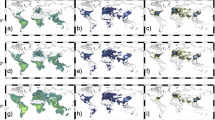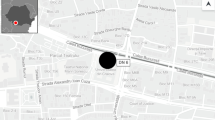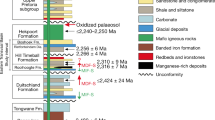Abstract
OZONE is the most abundant oxidant in the troposphere and is generated in the stratosphere by the reaction of oxygen atoms, formed by photolysis, with molecular oxygen. Some is then transferred to the troposphere and 0–0.05 p.p.m. of ozone is found in unpolluted air at ground level1. Ozone can also be formed directly in tropospheric polluted air by the photolysis of NO2 in the presence of hydrocarbons; concentrations in excess of 0.15 p.p.m. are regularly recorded in Los Angeles2 and other cities of the United States. Significant increases in equivalent ozone concentrations over background levels have been recorded in Holland3—up to 0.10 p.p.m. in conditions suitable for the build up of photochemical oxidants. The ambient sulphur dioxide level was found to vary inversely with equivalent ozone level.
This is a preview of subscription content, access via your institution
Access options
Subscribe to this journal
Receive 51 print issues and online access
$199.00 per year
only $3.90 per issue
Buy this article
- Purchase on SpringerLink
- Instant access to full article PDF
Prices may be subject to local taxes which are calculated during checkout
Similar content being viewed by others
References
Junge, C. E., Air Chemistry and Radioactivity, 37 (Academic Press, New York and London, 1963).
Air Quality Data from the National Air Sampling Networks, 1964—1965 (US Department of Health, Education and Welfare, 1966).
Wisse, J. A., and Velds, C. A., Atmos. Environ., 4, 79 (1970).
Cadle, R. D., in Air Pollution Handbook (edit. by Magill, P. L., Holden, F. R., and Ackley, C.), 3 (McGraw-Hill, New York, 1956).
Leighton, P. A., Photochemistry of Air Pollution, 159 (Academic Press, New York, 1961).
Druett, H. A., and Packmann, L. P., Nature, 218, 699 (1968).
Darley, E. F., Stephens, E. R., Middleton, J. T., and Hanst, P. L., Intern. J. Air Pollution, 1, 155 (1959).
Dark, F. A., and Nash, T., J. Hyg., Camb., 68, 245 (1970).
Arnold, W. N., Intern. J. Air Pollution, 2, 167 (1959).
Cox, R. A., and Penkett, S. A., Atmos. Environ., 4, 425 (1970).
Cox, R. A., and Penkett, S. A., Nature, 229, 486 (1971).
Brewer, A. W., and Milford, J. R., Proc. Roy. Soc., A, 256, 470 (1960).
Wilson, jun., W. E., and Levy, A., J. Air Poll. Control Assoc., 20, 385 (1970).
Altshuller, A. P., and Bufalini, J. J., Photochem. Photobiol., 4, 97 (1965).
Altshuller, A. P., Kopczynski, S. L., Lonneman, W. A., Becker, T. L., and Slater, R., Environ. Sci. Tech., 1, 899 (1967).
Druett, H. A., and May, K. R., Nature, 220, 395 (1968).
Druett, H. A., and May, K. R., New Scientist, March 13 (1969).
Author information
Authors and Affiliations
Rights and permissions
About this article
Cite this article
COX, R., PENKETT, S. Oxidation of Atmospheric SO2 by Products of the Ozone–Olefin Reaction. Nature 230, 321–322 (1971). https://doi.org/10.1038/230321a0
Received:
Issue date:
DOI: https://doi.org/10.1038/230321a0
This article is cited by
-
Open questions on the reactivity of Criegee intermediates
Communications Chemistry (2021)
-
The X factor
Nature (2012)
-
A new atmospherically relevant oxidant of sulphur dioxide
Nature (2012)
-
Rate evaluation of marble damage by SO2-acidity in the vicinity of stacks
Environmental Geochemistry and Health (1992)
-
Global emissions and natural processes for removal of gaseous pollutants
Water, Air, and Soil Pollution (1975)



